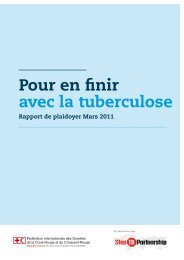stride - Stop TB Partnership
stride - Stop TB Partnership
stride - Stop TB Partnership
Create successful ePaper yourself
Turn your PDF publications into a flip-book with our unique Google optimized e-Paper software.
ACTG A5221 STRIDE: An international randomized<br />
trial of immediate vs early antiretroviral therapy<br />
(ART) in HIV+ patients treated for tuberculosis<br />
D Havlir, P Ive, M Kendall, A Luetkemeyer, S Swindells, J<br />
Kumwenda, J Rooney, S Qasba, E Hogg, J Andersen, I Sanne<br />
ACTG SITE INVESTIGATORS<br />
Mina Hosseinipour<br />
Umesh Lalloo<br />
Valdilea Veloso<br />
Fatuma Some<br />
N. Kumarasamy<br />
Nesri Padayatchi<br />
Breno Santos<br />
Stewart Reid<br />
James Hakim<br />
Lerato Mohapi<br />
Peter Mugyenyi<br />
Constance Benson<br />
Jorge Sanchez<br />
Javier Lama<br />
Jean William Pape<br />
Fred Sattler<br />
Aida Asmelash<br />
Evans Moko<br />
Frederick Sawe<br />
Mauro Schechter<br />
Thira Sirisanthana<br />
Srikanth Tripathy<br />
Judith Aberg
BACKGROUND<br />
● HIV-associated <strong>TB</strong> is a major cause of<br />
morbidity and mortality globally<br />
● ART started prior to completion of <strong>TB</strong><br />
therapy reduces mortality 1<br />
● However, the optimal time to start ART<br />
during <strong>TB</strong> treatment has not been<br />
established<br />
● Clinicians often must decide when to start<br />
ART prior to the confirmation of <strong>TB</strong><br />
1<br />
Abdool Karim, NEJM, 2010
HYPOTHESIS<br />
In patients starting treatment for <strong>TB</strong>, the<br />
immediate initiation of ART (within 2 weeks)<br />
could reduce mortality and morbidity compared<br />
to the early initiation of ART (8-12 weeks)
STUDY DESIGN<br />
●<br />
●<br />
Phase IV, randomized, open-label strategy study<br />
HIV+ adults with confirmed or presumed <strong>TB</strong><br />
● CD4
STUDY SCHEMA<br />
IMMEDIATE<br />
ART<br />
HIV+<br />
<strong>TB</strong><br />
CD4
STUDY ENDPOINTS<br />
●<br />
●<br />
Primary: all-cause mortality and new AIDSdefining<br />
illnesses by 48 weeks<br />
• Proportions estimated using the Kaplan-Meier method<br />
• Stratified analysis by weighting by the inverse of the<br />
Greenwood's variance in each CD4 stratum<br />
Secondary:<br />
• Safety<br />
• CD4, HIV RNA changes<br />
• <strong>TB</strong> IRIS 1<br />
• <strong>TB</strong> outcomes<br />
1<br />
Required 1 major or 2 minor criteria Meintjes, Lancet ID, 2008
RESULTS: Baseline characteristics<br />
Treatment arm<br />
Immediate Early All<br />
N=405 N=401 N=806<br />
Study Site<br />
Africa 275 279 554<br />
Asia 29 23 52<br />
N. America<br />
21 18 39<br />
S. America<br />
80<br />
81<br />
161<br />
Confirmed <strong>TB</strong> 48% 45% 46%<br />
Median CD4 cells/mm 3 70 82 77<br />
(IQR)<br />
(34,146) (40,144) (36, 145)<br />
Median log 10 HIV RNA 5.39 5.50 5.43<br />
EVF/TDF/FTC<br />
98% 96% 97%<br />
Median time to ART 10 days 70 days n.a.
RESULTS: Proportion with AIDS/Death<br />
Immediate<br />
Early<br />
P (95% CI for<br />
difference)<br />
All Subjects 12.9% 16.1% 0.45 (-1.8, 8.1)<br />
CD4
RESULTS: Proportion with AIDS/Death<br />
Immediate<br />
Early<br />
P (95% CI for<br />
difference)<br />
All Subjects 12.9% 16.1% 0.45 (-1.8, 8.1)<br />
CD4
Time-to-New AIDS-Defining Illness or Death<br />
by CD4 Stratum
Primary Endpoint: AIDS<br />
AIDS Illness Immediate ART Early ART Total<br />
(N=26)<br />
(N=37)<br />
(N=63)<br />
Cryptococcal Disease 6 7 13<br />
Esophogeal Candidiasis 4 8 12<br />
Kaposi’s Sarcoma 3 8 11<br />
Pneumocystis pneumonia 3 3 6<br />
Toxoplasmosis 2 3 5<br />
Cytomegalovirus 2 2 4<br />
Non-<strong>TB</strong> Mycobacteria 2 1 3<br />
Other 4 5 9
Deaths<br />
Cause Immediate Early Total<br />
(N=31) (N=37) (N=68)<br />
Tuberculosis 14 7 21<br />
AIDS Related<br />
Bacterial infection 3 7 10<br />
Cryptococcus 2 3 5<br />
CMV 1 1 2<br />
MAC 1 1 2<br />
Lymphoma 0 1 1<br />
Toxoplasmosis 0 1 1<br />
Non AIDS 6 10 16<br />
Trauma/suicide/ingestion 2 2 4<br />
Unknown 2 4 6
Grade 3 or 4 Clinical Events or<br />
Laboratory Abnormalities<br />
Event Immediate Early Total<br />
Constitutional 8% 8% 8%<br />
Respiratory 4% 4% 4%<br />
Cardiac/Circulatory 3% 2% 2%<br />
Gastrointestinal 4% 5% 5%<br />
Skin 3% 3% 3%<br />
Neurological 5% 7% 6%<br />
ANC < 750/mm 3 * 9% 17% 13%<br />
Hemoglobin 7% 5% 6%<br />
Platelets
HIV RNA and CD4 Responses<br />
HIV RNA suppression 74% at 48 weeks<br />
No difference between arms<br />
CD4 change 156 cells: entry to week 48<br />
No difference between arms
Frequency and Predictors of<br />
M<strong>TB</strong> IRIS<br />
Frequency 1<br />
# M<strong>TB</strong> IRIS<br />
Immediate ART 43 (11%)<br />
Predictor<br />
Hazard P<br />
(95% CI) 1 Value<br />
Immediate ART 2.5 (1.4, 4.2) 0.001<br />
Early ART<br />
19 (5%)<br />
HIV RNA Higher 1.8 (1.2, 2.7) 0.007<br />
Confirmed <strong>TB</strong> 2 3.6 (2.0, 6.6)
Summary<br />
●<br />
Overall, immediate ART did not reduce AIDSdefining<br />
illnesses and death compared to early<br />
ART<br />
● However, for persons with CD4+ counts< 50/mm 3 ,<br />
immediate ART reduced mortality/AIDS<br />
●<br />
●<br />
●<br />
Grade 3 or 4 toxicities did not differ between arms<br />
No differences in HIV RNA suppression rates<br />
(74%) or CD4 rise between arms<br />
<strong>TB</strong> IRIS was higher in immediate vs early arms
When to Start ART in <strong>TB</strong> – Building<br />
on previous studies<br />
A5221/ STRIDE CAMELIA 1 SAPIT 2<br />
N 806 660 429<br />
Sites<br />
Africa, Asia, S Am, N<br />
Am<br />
Cambodia<br />
S. Africa<br />
Arms Imm vs 8-12 wk Imm vs 8 wk Early vs 24 wk<br />
Endpt Death/AIDS
Conclusions<br />
●<br />
●<br />
●<br />
●<br />
Both immediate and early ART strategies are<br />
safe and do not jeopardize CD4 or viral<br />
suppression rates<br />
In patients with CD4
Acknowledgments<br />
●<br />
●<br />
●<br />
●<br />
●<br />
●<br />
●<br />
●<br />
Study patients, families and care providers<br />
Other 5221 STRIDE team members: Fran Aweeka, Eva<br />
Purcelle, Ana Martinez, Travis Behm, Patricia Anthony,<br />
Janet Nicotera, Margaret Mensah-King, Stephanie Warner,<br />
Christina Blanchard, Xingye (Shirley) Wu<br />
Carol Suckow and Lynne Jones, Data Managers<br />
HIV and <strong>TB</strong> care programs<br />
Veronica Miller, Forum for Collaborative Research<br />
NIAID, Richard Hafner<br />
Members of the DSMB<br />
Gilead Sciences and Merck Pharmaceuticals


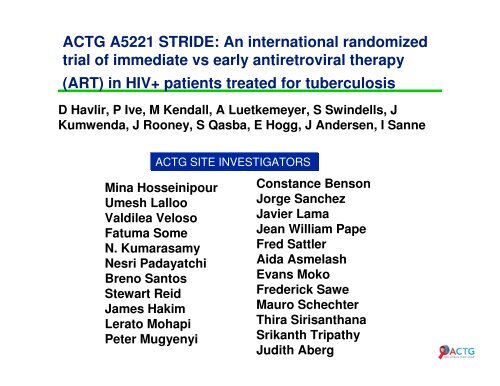
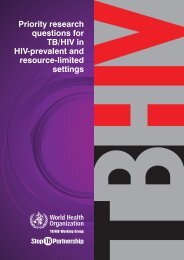
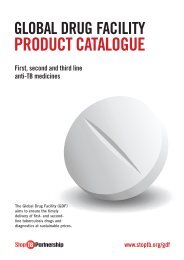
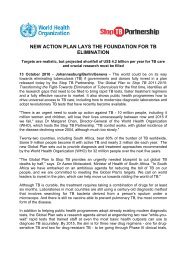
![Global Drug Facility Annual Report 2011 [.pdf] - Stop TB Partnership](https://img.yumpu.com/26788745/1/184x260/global-drug-facility-annual-report-2011-pdf-stop-tb-partnership.jpg?quality=85)

![Concept note on national stop TB partnership [.pdf]](https://img.yumpu.com/26788741/1/184x260/concept-note-on-national-stop-tb-partnership-pdf.jpg?quality=85)
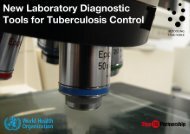

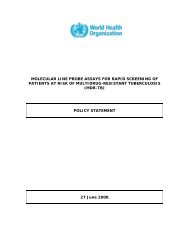
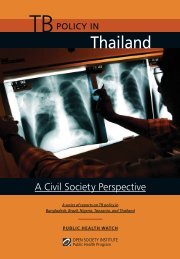
![2005 and Challenges for 2006 - 2015 [.pdf] - Stop TB Partnership](https://img.yumpu.com/26788674/1/190x245/2005-and-challenges-for-2006-2015-pdf-stop-tb-partnership.jpg?quality=85)
![Brochure (French) [.pdf] - Stop TB Partnership](https://img.yumpu.com/17234792/1/190x91/brochure-french-pdf-stop-tb-partnership.jpg?quality=85)

